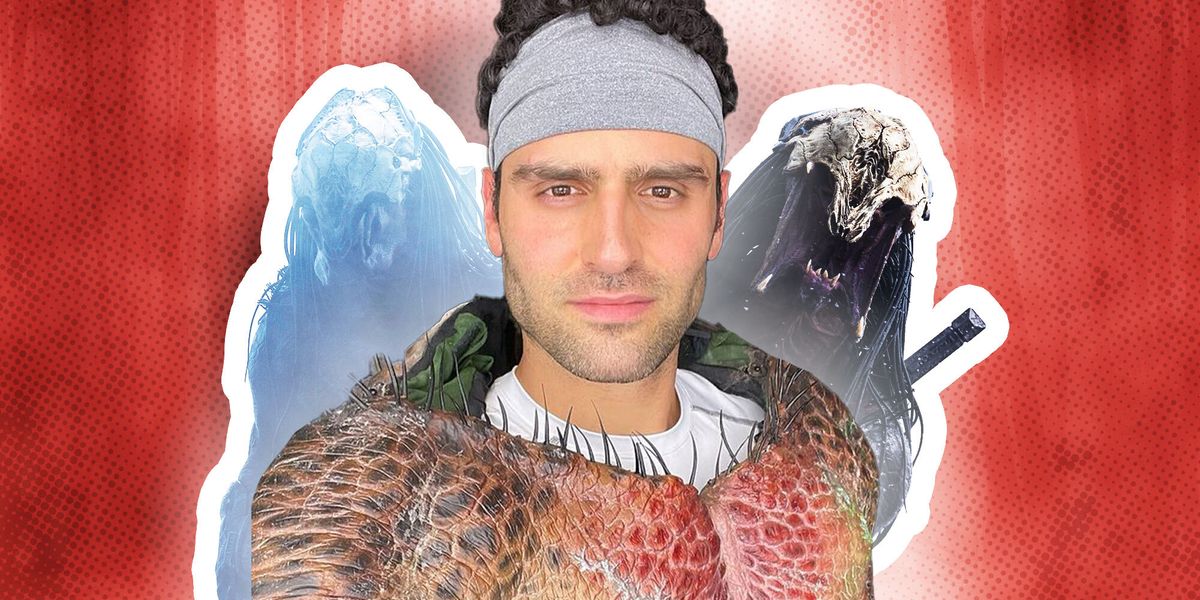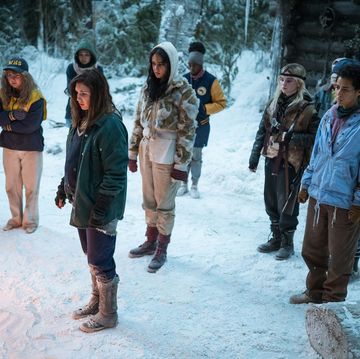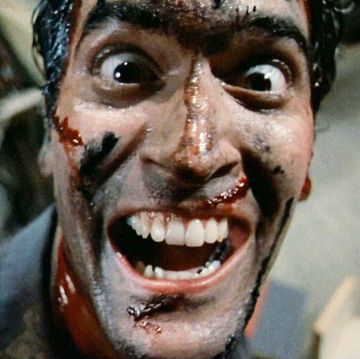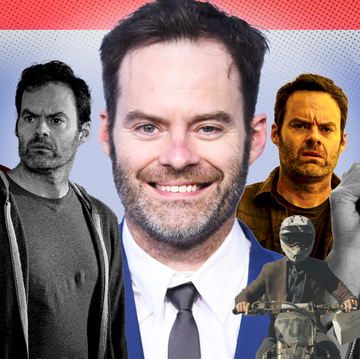LAST SUMMER, Dane DiLiegro would wake up every morning and stare at the ceiling.
“There’s that 4-second window where you forget what’s going on, and you have that hardwired mentality that you’re just a person living their life. And then I’d remember, ‘Oh, shit—I’m the Predator.”
The 6’9 former D1 college athlete has since moved on from palming basketballs with ease, trading in his jersey for a career of heavy foam latex and layers upon layers of detailed prosthetic makeup. His latest bout—following other work as on-screen fictional creatures like Sweet Home's Muscle Monster and Ba'al on American Horror Stories—brought him to the 1700s in Dan Trachtenberg’s Prey, a prequel entry to the longstanding Predator franchise. DiLiegro had the honor of portraying the earliest iteration of the humanoid space monster known for treating humans as play things, this time setting its sights on a Comanche warrior named Naru (Amber Midthunder) and the rest of her tribe.
More From Men's Health

While this might be the 7th time we’re seeing the infamous alien species on screen, the version we see in Prey is technically the very first time—that we know of, at least—it has appeared on Earth. Meaning Trachtenberg and DiLiegro really had the opportunity to shift gears and show us a more “animalistic, lean, and dynamic” version of the Predator.
“[Dan] didn’t want Kevin Peter Hall, who played the original Predator in the first and second films,” DiLiegro tells Men’s Health. “He didn’t want that WWF 1987 wrestler standoff type thing. He wanted a departure, which is great for me because it gave me a high creative ceiling to do what I want for this character. It’s fast and feral, and I’m thinking it’s more like a panther and something feline. I wanted this Predator to look like if he’s running through the woods, he’s done it 100,000 times. He knows every root, tree, and branch. I really got an opportunity to show my athleticism, and it translated very well on screen.”
It turns out there’s a lot more to playing a legendary extraterrestrial species than meets the eye: conceptualizing the character’s motivation, weeks of functional strength and conditioning training, and swimming in gallons of sweat under a 80-pound suit, for instance.
We talked with DiLiegro about going from the basketball court to creature acting, the physical advantages that come from his background as a pro athlete, and not getting pigeonholed as a makeup-covered monster for the rest of his life.
Men's Health: When you're not far off from 7 feet tall, basketball seems like a reasonable career route. At what point did you put the ball down and go, “I want to be in monster movies,” and not just be in them, but be the monster?
Dane DiLiegro: I played 4 years of D1 college basketball. I went on to play pro for 8 years—7 years in Italy and 1 year in Israel. I was also with the Boston Celtics for a summer. 3 summers ago in 2019, I essentially was scouted by a stunt coordinator in Boston who recommended I look into acting due to my size and athleticism. Two weeks later, I booked a Netflix show called Sweet Home, playing a character called Muscle Monster. I had to move to LA for what I thought was 3 months, and here I am still in the same apartment. I’ve been studying to do face acting, but there is definitely an advantage at play [to creature acting] with my size, athleticism, and sports background. I still train every day like I'm a pro athlete, and I have to carry that with me when I come into a new role, whether new role or non-human.
How do you find yourself preparing for a role when you know your actual face won't be seen? Do you look anywhere in particular for inspiration?
Typically, I need to see the design of the character I play before anything. A lot of the characters I play are non-verbal, which requires me to tell a story without words. For me, the way I base my characters and what drives them and what moves them, I need to see the design first.
For Predator, he’s got that feral animal hunched back, spines on him, the fin, Japanese ghost dreads. All those designs of the character drove how that character moved and motivated him. When you’re developing a character, you have to figure out what their wants, needs, desires, fears are. When you’re under the rubber as a non-human, it’s easy to forget you’re this thing. You can’t always look in the mirror, so being cognizant of that definitely comes into play as well.
How does working with motion capture compare to when you're acting in a suit under prosthetics?
I did all the acting, stunts, and motion capture for Predator, and motion capture is very taxing on the body. It’s not for the faint of heart. We spent a day in a free running academy, and I ran around this facility in a motion capture inertia suit doing all the motions that the Predator does. Whether it was something as simple as walking, walking and slashing, running and slashing, jumping, leaping, doing moves with weaponry. Then we got into more taxing things: running, sprinting and then jumping off a ledge into a foam pit and swinging my arm back and pretending to slash someone, or pretending I was hanging off a tree and jumping off of that into another tree. All of the actions you see him doing, whether CGI or practical, is me actually doing those things.
You said you’re still training like a pro athlete. With a sports background, how have those physical skills and attributes played into this chapter of your career?
As a basketball player, I was never the most talented guy in the gym. I had to rely on my hard work and effort, stamina, and endurance. I do a lot of strength and conditioning now, typically in the morning. I’m doing functional training that keeps my body where it needs to be, and keeps my joints and all things that bend in a 6’9 guy that are required to keep me together. I perform a lot of maintenance on those.
I do a lot of conditioning in the afternoon. Whether it’s hiking, biking, or a lot of times I'll go to a soccer field and bring it back to my basketball days with suicides. I'll do 70 yard shuttles. It’s that intermittent intensity that is required. A lot of those exercises I do are unsexy, but they are very important in keeping my body together in order to give me the ability to do what I need to do. Each take, you’re exerting yourself between 15 seconds to a minute, and you have to be able to do it over and over again.
Do you feel as though you have an advantage over other actors that don’t have the height, the general physicality, and the stamina?
Definitely a huge advantage. Your body needs to be in a place where you’re able to run, jump, leap, swing, punch, and do a lot of physical acting without getting hurt. It takes a special person. With my larger size comes more strength. I can stand up to a 150 pound suit if I need to in order to make it through. And you’re not just doing this for one day—you’re doing it for a day that’s 16 hours, and then you could be doing that same thing for 3 months straight. You have to be as fresh in the beginning of the shoot as you are at the end of the shoot.
And what about dieting? I’m sure you also had to maintain some type of regime so you could fit into the same suit every day.
I had to lose 25 pounds for this role. I eliminated breakfast, and I did a lot of intermittent fasting. Typically (and this is my basketball diet), I steer away from flour, dairy, and sugar. You can only eat it if it walks, swims, flies, or comes out of the ground. Sugar is the killer, and if I break my rules, it's typically dairy. I will have a cheeseburger or pizza every now and then because they’re just important things.
I try to eat what the Earth provides us. It was difficult to maintain that because I’m sweating and working hard all day, and I have to eat. You get energy from carbs, so it was a tricky dance between eating enough where it didn’t affect my body and also having the energy to sustain me through the long days of shooting.
Once the Predator comes down from the ship, you join in as one of the main players with a fair amount of screen time. What’s the pressure like when performing knowing that you might not have lines, but you’re still a crucial part of the film?
There’s a lot of accountability that comes to playing this character. At the same point, very similar to pro sports, you cannot let things get you too hyped up. You have to stay consistent and stay with the mindset of 'I was meant to do this.' I’m showing up to work and perform, and it’s very easy to psyche yourself out. You have to show up and be a little mindless, but be on top of your stuff.
Did you finish filming eager to take on your next creature role, or are you seeking something a little less physically aggressive?
It's half and half for me. I could play Predator all day. Some of those bigger iconic characters—Jason Voorhees in Friday the 13th, or maybe a Xenomorph in an Alien movie would be great. I love all that. But at the same point, I can play humans and have my face out there. I can be a doctor, a lawyer, a soldier. I’d rather not get pigeonholed in my career the further down this monster tunnel I go. They're really fun, and I’d gladly take all the monster roles, but I want to be a human as well. If I could not have to sit through so much makeup and just wear a t-shirt, that would be a very nice breath of fresh air. I’m not complaining, I’m just open to everything.
How much are you going to miss being the Predator? Did you have a love/hate relationship with being in that suit?
When you’re on camera as a human, it’s very raw, visceral, and in your face with 300 people watching you. When you cover yourself in latex, you can do whatever you want because it’s not you. People can’t see you. It gives you a freedom, and makes it easier to let go and perform this character how you want to. You have this foam bubble of latex which makes it very freeing and liberating, which is nice.
But you’re also covered in 80 pounds of foam latex, which is essentially a sponge. When you sweat, and when you’re in Calgary in the middle of the summer and it’s over 95 degrees, you’re sweating. It’s sitting there in the suit, and it gets heavier and wetter as the days go on. Every time I swung my arm, you’d see sweat squirt out the sides and out of my knees. It can be unpleasant, and you have to be comfortable with being uncomfortable at times. It was challenging, to say the least.
Sean Abrams is the Senior Editor, Growth and Engagement at Men’s Health. He’s a former hip hop dancer who likes long walks on the beach and large glasses of tequila. You can find his previous work at Maxim, Elite Daily, and AskMen.












